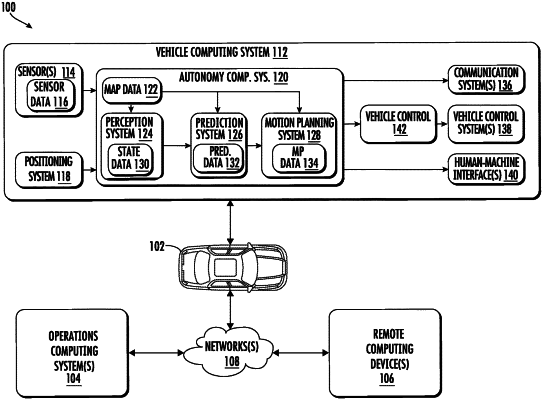| CPC B60W 60/0011 (2020.02) [B60W 30/095 (2013.01); B60W 40/10 (2013.01); B60W 60/0016 (2020.02); B60W 2554/4041 (2020.02)] | 19 Claims |

|
1. A computer-implemented method for generating autonomous vehicle paths, the method comprising:
accessing, by a computing system including one or more processors, map data for a geographic area and sensor data for the geographic area around an autonomous vehicle;
identifying, by the computing system and based on the map data and the sensor data, object data describing a position and a size of one or more objects in the geographic area of the autonomous vehicle;
accessing, by the computing system, path data describing a nominal path through the geographic area, wherein the nominal path comprises a single series of points;
determining, by the computing system, a plurality of corridor segments associated with the nominal path, wherein the plurality of corridor segments correspond to a series of locations along the nominal path described in the path data, each location being associated with an expected position of the autonomous vehicle at a particular point in time and a width of each corridor segment is defined by a left offset distance from the location and a right offset distance from the location, wherein determining, by the computing system, the plurality of corridor segments associated with the nominal path comprises:
for at least one respective location in the series of locations:
accessing, by the computing system, the object data for one or more of the objects in the geographic area of the respective location;
for each object described in the object data:
determining, by the computing system, whether the object blocks the nominal path in the respective location; and
in response to determining that the object blocks the nominal path:
determining, by the computing system, a passing side for the nominal path; and
adjusting, by the computing system, the left offset distance to a negative value if a right side is the passing side and adjusting the right offset distance to a negative value if a left side is determined to be the passing side such that at least one point in the single series of points is not within the plurality of corridor segments;
generating, by the computing system, a vehicle motion corridor by aggregating the plurality of corridor segments, wherein the vehicle motion corridor defines an area in which the autonomous vehicle can travel without colliding with the one or more objects; and
controlling, by the computing system, the autonomous vehicle, based at least in part, on the vehicle motion corridor.
|